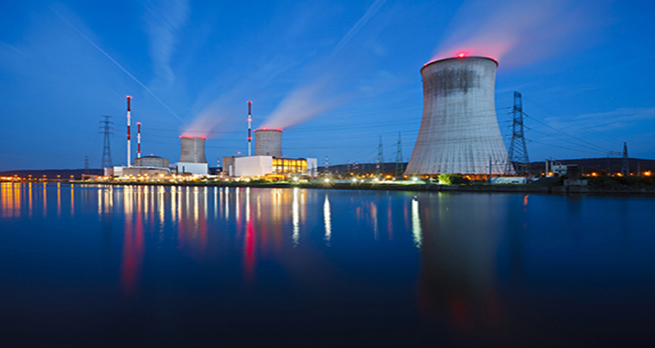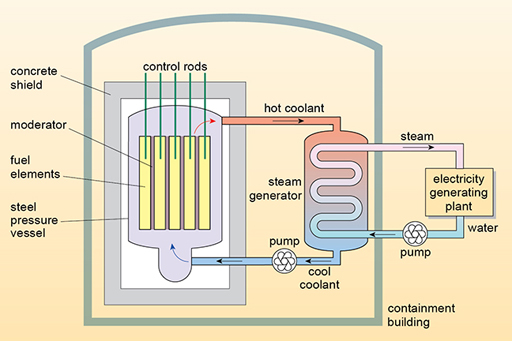3.1.1 What can go wrong in a nuclear power station?
The design of every nuclear power station includes many safeguards that are put in place to ensure that the core is protected from the environment.
Every serious nuclear accident has arisen because a sequence of events has led to the core going into meltdown. You have probably heard of the term meltdown before. It is an informal term for the more technical descriptions core melt accident and partial core melt.
A meltdown occurs when the heat in the core of the reactor rises high enough that the fuel rods begin to melt. This can have disastrous consequences as, under these circumstances, the fuel cladding can be breached and highly radioactive materials leak into the environment beyond.
Have a look at Figure 1 to remind yourself of the layout of a nuclear reactor.
There are three different situations that can lead to a meltdown:
Control of the fission reaction is lost and the reactor goes supercritical
You will recall that for a critical reaction the population of neutrons is such that the number of fission events is steady and that the chain reaction continues in a controlled manner and releases a manageable amount of energy. The reactor will be designed to have some tolerance, but there will be a limit to the amount of heat energy that the coolant can safely transport away.
If the number of neutrons is allowed to increase, the number of fission events increases and the chain reaction releases progressively more and more energy. This uncontrolled chain reaction is what is allowed to happen in a nuclear bomb but needs to be avoided in a power station!
The control rods control the number of neutrons. A supercritical reaction can occur if the control rods are not adequately inserted within the fuel.
In April 1986, the Chernobyl nuclear power plant was running tests on one of the four reactors based there. The nature of the test led to the control rods being fully pulled out from the fuel before the test began, as the fission product xenon (Xe) had begun to build up which is itself a neutron absorber.
Once the test started the fission began to go supercritical and the control rods could not be inserted again quickly enough. The reactor was no longer under control and rapidly jumped to ten times its usual energy output (some reports have the final measured output as 100 times higher). This led to two explosions in the core.
The fuel elements became exposed and extremely radioactive materials were released into the environment. Chernobyl is considered the worst nuclear power disaster in history.
Coolant failure
All may be well with the fuel rods and the criticality of the fission reaction but if the coolant fails and the heat is allowed to build up then the temperature can become dangerous in the reactor core. Heat will build up even if the fission reaction itself has been stopped. This is due to the radioactivity of the fission products within the fuel rods. These will be highly active and able to heat the surroundings sufficiently to melt the fuel rods.
At Three Mile Island a partial meltdown occurred in one of the two reactors on the site. A small valve was accidentally stuck open and allowed coolant to escape. It took a while for operators to understand the situation and in the interim some steps were taken that made matters worse, in particular the decision to release more of the coolant.
The temperature rise was slower than at Chernobyl but the delays allowed the diminishing coolant to expose fuel elements within about two hours of the initial malfunction. The cladding around the fuel elements was damaged and radioactive isotopes leaked into the remaining coolant and into the surrounding environment.
A coolant failure also occurred at Fukushima which you will look at in more depth later in the week.
Fire within a reactor
The reactor that was built in Windscale used carbon graphite as the moderator. The graphite was therefore bombarded with neutrons which led it to a change of structure, allowing energy to build up with each new neutron interaction.
This process was known about (it is called Wigner energy) and efforts were made to release it. However, in October 1957, the release of the Wigner energy was not successful and the moderator caught fire, which soon spread to the fuel elements.
Windscale was an air-cooled power station and this air was vented up and out of a chimney. The fire in the core caused radioactive materials to escape out through the chimney with the air and into the surrounding environment. Lessons were learned from the events at Windscale and the Magnox design of reactor was phased out.
Next, you will find out more about the accidents at Three Mile Island and Chernobyl.

